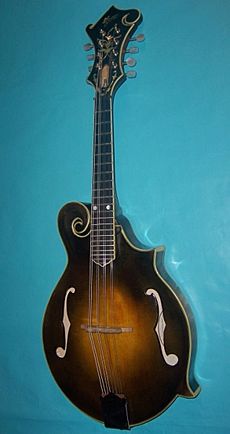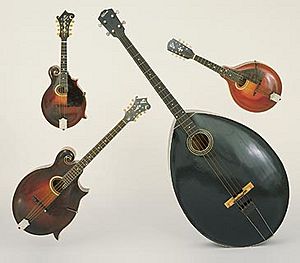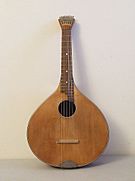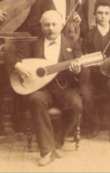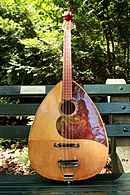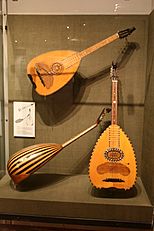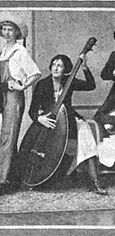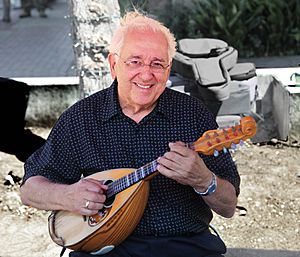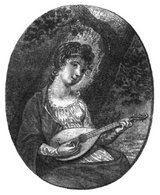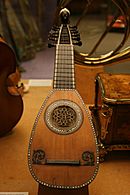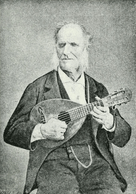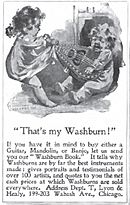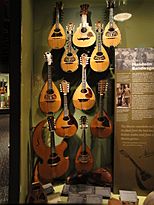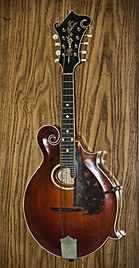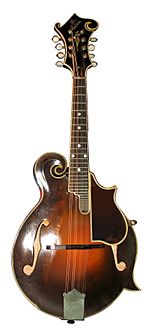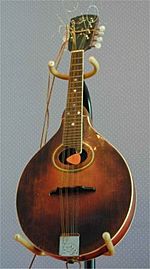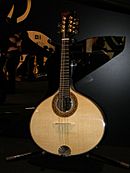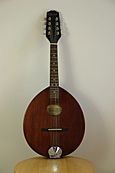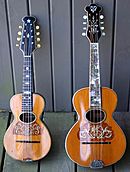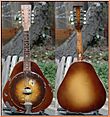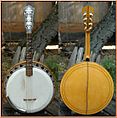Mandolin facts for kids
The mandolin is a musical instrument, which literally means, a small soprano member of the lute family. It is played by hitting its strings and sounds similar in tone of a violin or a hammered dulcimer. The most common type of mandolin, which was first designed in Naples, has eight strings. It has a body made of wood and a fingerboard which has frets.
Contents
Mandolin family
Soprano
The mandolin is the soprano member of the mandolin family, as the violin is the soprano member of the violin family. Like the violin, its scale length is typically about 13 inches (330 mm). Modern American mandolins modelled after Gibsons have a longer scale, about 13+7⁄8 inches (350 mm). The strings in each of its double-strung courses are tuned in unison, and the courses use the same tuning as the violin: G3–D4–A4–E5.
The piccolo or sopranino mandolin is a rare member of the family, tuned one octave above the mandola and one fourth above the mandolin (C4–G4–D5–A5); the same relation as that of the piccolo or sopranino violin to the violin and viola. One model was manufactured by the Lyon & Healy company under the Leland brand. A handful of contemporary luthiers build piccolo mandolins. Its scale length is typically about 9+1⁄2 inches (240 mm).
Alto
- The mandola (US and Canada), termed the tenor mandola in Britain and Ireland and liola or alto mandolin in continental Europe, which is tuned to a fifth below the mandolin, in the same relationship as that of the viola to the violin. Some also call this instrument the "alto mandola." Its scale length is typically about 16+1⁄2 inches (420 mm). It is normally tuned like a viola (fifth below the mandolin): C3–G3–D4–A4.
Tenor
- The octave mandolin (US and Canada), termed the octave mandola in Britain and Ireland and mandola in continental Europe, is tuned an octave below the mandolin: G2–D3–A3–E4. Its relationship to the mandolin is that of the tenor violin to the violin. Octave mandolin scale length is typically about 20 inches (510 mm), although instruments with scales as short as 17 inches (430 mm) or as long as 21 inches (530 mm) are not unknown.
- Bandol: The instrument has a variant off the coast of South America in Trinidad, where it is known as the bandol, a flat-backed instrument with four courses, the lower two strung with metal and nylon strings.
- The Irish bouzouki, although not strictly a member of the mandolin family, has a resemblance and similar range to the octave mandolin. It was derived from the Greek bouzouki (a long-necked lute), constructed like a flat-backed mandolin and uses fifth-based tunings, most often G2–D3–A3–E4 (an octave below the mandolin)—in which case it essentially functions as an octave mandolin. Common alternate tunings include: G2–D3–A3–D4, A2–D3–A3–D4 or A2–D3–A3–E4. Although the Irish bouzouki's bass course pairs are most often tuned in unison, on some instruments one of each pair is replaced with a lighter string and tuned in octaves, in the fashion of the 12-string guitar. While occupying the same range as the octave mandolin/octave mandola, the Irish bouzouki is theoretically distinguished from the former instrument by its longer scale length, typically from 22 to 24 inches (560 to 610 mm), although scales as long as 26 inches (660 mm), which is the usual Greek bouzouki scale, are not unknown. In modern usage, however, the terms "octave mandolin" and "Irish bouzouki" are often used interchangeably to refer to the same instrument.
- The modern cittern may also be loosely included in an "extended" mandolin family, based on resemblance to the flat-backed mandolins, which it predates. Its own lineage dates it back to the Renaissance. It is typically a five course (ten string) instrument having a scale length between 20 and 22 inches (510 and 560 mm). The instrument is most often tuned to either D2–G2–D3–A3–D4 or G2–D3–A3–D4–A4, and is essentially an octave mandola with a fifth course at either the top or the bottom of its range. Some luthiers, such as Stefan Sobell also refer to the octave mandola or a shorter-scaled Irish bouzouki as a cittern, irrespective of whether it has four or five courses.
- Other relatives of the cittern, which might also be loosely linked to the mandolins (and are sometimes tuned and played as such), include the 6-course/12-string Portuguese guitar and the 5-course/9-string waldzither.
Baritone/Bass
The mandolone was a Baroque member of the mandolin family in the bass range that was surpassed by the mandocello. Built as part of the Neapolitan mandolin family.
- The mandocello, which is classically tuned to an octave plus a fifth below the mandolin, in the same relationship as that of the cello to the violin: C2–G2–D3–A3. Its scale length is typically about 25 inches (640 mm). A typical violoncello scale is 27 inches (690 mm).
The Greek laouto or laghouto (long-necked lute) is similar to a mandocello, ordinarily tuned C3/C2–G3/G2–D3/D3–A3/A3 with half of each pair of the lower two courses being tuned an octave high on a lighter gauge string. The body is a staved bowl, the saddle-less bridge glued to the flat face like most ouds and lutes, with mechanical tuners, steel strings, and tied gut frets. Modern laoutos, as played on Crete, have the entire lower course tuned to C3, a reentrant octave above the expected low C. Its scale length is typically about 28 inches (710 mm).
The Algerian mandole was developed by an Italian luthier in the early 1930s, scaled up from a mandola until it reached a scale length of approximately 25-27 inches. It is a flatback instrument, with a wide neck and 4 courses (8 strings), 5 courses (10 strings) or 6 courses (12 strings). Used in music in Algeria and Morocco. The instrument can be tuned as a guitar, oud or mandocello, depending on the music it will be used to play and player preference. When tuning it as a guitar the strings will be tuned (E2) (E2) A2 A2 D3 D3 G3 G3 B3 B3 (E4) (E4). Strings in parenthesis are dropped for a five or four course instrument. Using a common Arabic oud tuning D2 D2 G2 G2 A2 A2 D3 D3 (G3) (G3) (C4) (C4). For a mandocello tuning using fifths C2 C2 G2 G2 D3 D3 A3 A3 (E4) (E4).
Contrabass
- The mando-bass most frequently has 4 single strings, rather than double courses, and is tuned in fourths like a double bass or an acoustic bass guitar: E1–A1–D2–G2. These were made by the Gibson company in the early 20th century, but appear to have never been very common. A smaller scale four-string mandobass, usually tuned in fifths: G1–D2–A2–E3 (two octaves below the mandolin), though not as resonant as the larger instrument, was often preferred by players as easier to handle and more portable. Reportedly, however, most mandolin orchestras preferred to use the ordinary double bass, rather than a specialised mandolin family instrument. Calace and other Italian makers predating Gibson also made mandolin-basses.
- The relatively rare eight-string mandobass, or tremolo-bass also exists, with double courses like the rest of the mandolin family, and is tuned either G1–D2–A2–E3, two octaves lower than the mandolin, or C1–G1–D2–A2, two octaves below the mandola.
Variations
Bowlback
Bowlback mandolins (also known as roundbacks), are used worldwide. They are most commonly manufactured in Europe, where the long history of mandolin development has created local styles. However, Japanese luthiers also make them.
Owing to the shape and to the common construction from wood strips of alternating colors, in the United States these are sometimes colloquially referred to as the "potato bug" or "potato beetle" mandolin.
Neapolitan and Roman styles
The Neapolitan style has an almond-shaped body resembling a bowl, constructed from curved strips of wood. It usually has a bent sound table, canted in two planes with the design to take the tension of the eight metal strings arranged in four courses. A hardwood fingerboard sits on top of or is flush with the sound table. Very old instruments may use wooden tuning pegs, while newer instruments tend to use geared metal tuners. The bridge is a movable length of hardwood. A pickguard is glued below the sound hole under the strings. European roundbacks commonly use a 13-inch (330 mm) scale instead of the 13+7⁄8 inches (350 mm) common on archtop Mandolins.
Intertwined with the Neapolitan style is the Roman style mandolin, which has influenced it. The Roman mandolin had a fingerboard that was more curved and narrow. The fingerboard was lengthened over the sound hole for the E strings, the high pitched strings. The shape of the back of the neck was different, less rounded with an edge, the bridge was curved making the G strings higher. The Roman mandolin had mechanical tuning gears before the Neapolitan.
Prominent Italian manufacturers include Vinaccia (Naples), Embergher (Rome) and Calace (Naples). Other modern manufacturers include Lorenzo Lippi (Milan), Hendrik van den Broek (Netherlands), Brian Dean (Canada), Salvatore Masiello and Michele Caiazza (La Bottega del Mandolino) and Ferrara, Gabriele Pandini.
Lombardic styles, Milanese, Cremonese and Brescian
Another family of bowlback mandolins came from Milan and Lombardy. These mandolins are closer to the mandolino or mandore than other modern mandolins. They are shorter and wider than the standard Neapolitan mandolin, with a shallow back. The instruments have 6 strings, 3 wire treble-strings and 3 gut or wire-wrapped-silk bass-strings. The strings ran between the tuning pegs and a bridge that was glued to the soundboard, as a guitar's. The Lombardic mandolins were tuned g–b–e′–a′–d″–g″ (shown in Helmholtz pitch notation). A developer of the Milanese stye was Antonio Monzino (Milan) and his family who made them for 6 generations.
Samuel Adelstein described the Lombardi mandolin in 1893 as wider and shorter than the Neapolitan mandolin, with a shallower back and a shorter and wider neck, with six single strings to the regular mandolin's set of 4. The Lombardi was tuned C–D–A–E–B–G. The strings were fastened to the bridge like a guitar's. There were 20 frets, covering three octaves, with an additional 5 notes. When Adelstein wrote, there were no nylon strings, and the gut and single strings "do not vibrate so clearly and sweetly as the double steel string of the Neapolitan."
Brescian Mandolin
Brescian mandolins that have survived in museums have four gut strings instead of six. The mandolin was tuned in fifths, like the Neapolitan mandolin.
Cremonese mandolin
In his 1805 mandolin method, Anweisung die Mandoline von selbst zu erlernen nebst einigen Uebungsstucken von Bortolazzi, Bartolomeo Bortolazzi popularised the Cremonese mandolin, which had four single-strings and a fixed bridge, to which the strings were attached. Bortolazzi said in this book that the new wire strung mandolins were uncomfortable to play, when compared with the gut-string instruments. Also, he felt they had a "less pleasing...hard, zither-like tone" as compared to the gut string's "softer, full-singing tone." He favored the four single strings of the Cremonese instrument, which were tuned the same as the Neapolitan.
Manufacturers outside Italy
In the United States, when the bowlback was being made in numbers, Lyon and Healy was a major manufacturer, especially under the "Washburn" brand. Other American manufacturers include Martin, Vega, and Larson Brothers.
In Canada, Brian Dean has manufactured instruments in Neapolitan, Roman, German and American styles but is also known for his original 'Grand Concert' design created for American virtuoso Joseph Brent.
German manufacturers include Albert & Mueller, Dietrich, Klaus Knorr, Reinhold Seiffert and Alfred Woll. The German bowlbacks use a style developed by Seiffert, with a larger and rounder body.
Japanese brands include Kunishima and Suzuki. Other Japanese manufacturers include Oona, Kawada, Noguchi, Toichiro Ishikawa, Rokutaro Nakade, Otiai Tadao, Yoshihiko Takusari, Nokuti Makoto, Watanabe, Kanou Kadama and Ochiai.
Archtop
At the very end of the 19th century, a new style, with a carved top and back construction inspired by violin family instruments began to supplant the European-style bowl-back instruments in the United States. This new style is credited to mandolins designed and built by Orville Gibson, a Kalamazoo, Michigan luthier who founded the "Gibson Mandolin-Guitar Manufacturing Co., Limited" in 1902. Gibson mandolins evolved into two basic styles: the Florentine or F-style, which has a decorative scroll near the neck, two points on the lower body and usually a scroll carved into the headstock; and the A-style, which is pear shaped, has no points and usually has a simpler headstock.
These styles generally have either two f-shaped soundholes like a violin (F-5 and A-5), or an oval sound hole (F-4 and A-4 and lower models) directly under the strings. Much variation exists between makers working from these archetypes, and other variants have become increasingly common. Generally, in the United States, Gibson F-hole F-5 mandolins and mandolins influenced by that design are strongly associated with bluegrass, while the A-style is associated other types of music, although it too is most often used for and associated with bluegrass. The F-5's more complicated woodwork also translates into a more expensive instrument.
Internal bracing to support the top in the F-style mandolins is usually achieved with parallel tone bars, similar to the bass bar on a violin. Some makers instead employ "X-bracing," which is two tone bars mortised together to form an X. Some luthiers now using a "modified x-bracing" that incorporates both a tone bar and X-bracing.
Numerous modern mandolin makers build instruments that largely replicate the Gibson F-5 Artist models built in the early 1920s under the supervision of Gibson acoustician Lloyd Loar. Original Loar-signed instruments are sought after and extremely valuable. Other makers from the Loar period and earlier include Lyon and Healy, Vega and Larson Brothers.
Flatback
Flatback mandolins use a thin sheet of wood with bracing for the back, as a guitar uses, rather than the bowl of the bowlback or the arched back of the carved mandolins.
Like the bowlback, the flatback has a round sound hole. This has been sometimes modified to an elongated hole, called a D-hole. The body has a rounded almond shape with flat or sometimes canted soundboard.
The type was developed in Europe in the 1850s. The French and Germans called it a Portuguese mandolin, although they also developed it locally. The Germans used it in Wandervogel.
The bandolim is commonly used wherever the Spanish and Portuguese took it: in South America, in Brazil (Choro) and in the Philippines.
In the early 1970s English luthier Stefan Sobell developed a large-bodied, flat-backed mandolin with a carved soundboard, based on his own cittern design; this is often called a 'Celtic' mandolin.
American forms include the Army-Navy mandolin, the flatiron and the pancake mandolins.
Tone
The tone of the flatback is described as warm or mellow, suitable for folk music and smaller audiences. The instrument sound does not punch through the other players' sound like a carved top does.
Double top, double back
The double top is a feature that luthiers are experimenting with in the 21st century, to get better sound. However, mandolinists and luthiers have been experimenting with them for at least since the early 1900s.
Back in the early 1900s, mandolinist Ginislao Paris approached Luigi Embergher to build custom mandolins. The sticker inside one of the four surviving instruments indicates the build was called after him, the Sistema Ginislao Paris). Paris' round-back double-top mandolins use a false back below the soundboard to create a second hollow space within the instrument.
Modern mandolinists such as Avi Avital and Joseph Brent use instruments customized, either by the luthier's choice or at the request of player. Joseph Brent's mandolin, made by Brian Dean also uses what Brent calls a false back. Brent's mandolin was the luthier's solution to Brent's request for a loud mandolin in which the wood was clearly audible, with less metallic sound from the strings. The type used by Avital is variation of the flatback, with a double top that encloses a resonating chamber, sound holes on the side, and a convex back. It is made by one manufacturer in Israel, luthier Arik Kerman. Other players of Kerman mandolins include Alon Sariel, Jacob Reuven, and Tom Cohen.
Others
Mandolinetto
Other American-made variants include the mandolinetto or Howe-Orme guitar-shaped mandolin (manufactured by the Elias Howe Company between 1897 and roughly 1920), which featured a cylindrical bulge along the top from fingerboard end to tailpiece and the Vega mando-lute (more commonly called a cylinder-back mandolin manufactured by the Vega Company between 1913 and roughly 1927), which had a similar longitudinal bulge but on the back rather than the front of the instrument.
Banjolin or mandolin-banjo
The mandolin was given a banjo body in an 1882 patent by Benjamin Bradbury of Brooklyn and given the name banjolin by John Farris in 1885. Today banjolin describes an instrument with four strings, while the version with the four courses of double strings is called a mandolin-banjo.
Resonator mandolin
A resonator mandolin or "resophonic mandolin" is a mandolin whose sound is produced by one or more metal cones (resonators) instead of the customary wooden soundboard (mandolin top/face). Historic brands include Dobro and National.
Electric mandolin
As with almost every other contemporary string instrument, another modern variant is the electric mandolin. These mandolins can have four or five individual or double courses of strings.
They have been around since the late 1920s or early 1930s depending on the brand. They come in solid body and acoustic electric forms.
Instruments have been designed that overcome the mandolin's lack of sustain with its plucked notes. Fender released a model in 1992 with an additional string (a high a, above the e string), a tremolo bridge and extra humbucker pickup (total of two). The result was an instrument capable of playing heavy metal style guitar riffs or violin-like passages with sustained notes that can be adjusted as with an electric guitar.
Images for kids
-
In 1787 Luigi Bassi played the role of Don Giovanni in Mozart's opera, serenading a woman with a mandolin. This used to be the common picture of the mandolin, an obscure instrument of romance in the hands of a Spanish nobleman.
-
A mandolone played by Giuseppe Branzoli during a concert in Rome, 1889
-
Italian mandolin virtuoso and child prodigy Giuseppe Pettine (here pictured in 1898) brought the Italian playing style to America where he settled in Providence, Rhode Island, as a mandolin teacher and composer. Pettine is credited with promoting a style where "one player plays both the rhythmic chords and the lyric melodic line at once, combining single strokes and tremolo."
See also
 In Spanish: Mandolina para niños
In Spanish: Mandolina para niños


